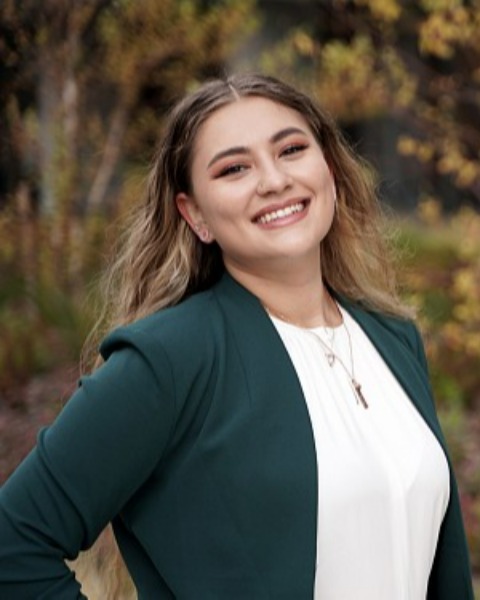Biomaterials
(B-78) Hyaluronic Acid-Alginate Hydrogels for the Treatment of Spinal Cord Injuries
- JK
Jenna Khachatourian (she/her/hers)
Undergraduate Research Assistant
University of Oregon Knight Campus
Eugene, Oregon, United States 
Alycia N. Galindo, BS (she/her/hers)
Graduate Research Fellow
University of Oregon Knight Campus for Accelerating Scientific Impact
Eugene, Oregon, United States
Marian H. Hettiaratchi
Assistant Professor
University of Oregon Knight Campus for Accelerating Scientific Impact, United States
Presenting Author(s)
Co-Author(s)
Primary Investigator(s)
Trauma to the central nervous system (CNS) can cause severe damage to tissues, resulting in impaired neurological capabilities.1 There is currently no treatment that completely restores the initial function of the CNS and delivery of therapeutics through the highly selective blood-spinal cord barrier remains a challenge.7 Injectable hydrogels can be modified to match properties of native CNS tissue and act as a substrate to promote axonal growth while serving as a delivery vehicle.5 We hypothesized that crosslinking hyaluronic acid (HA) and alginate (Alg) to form an HA-Alg hydrogel will produce an environment that stimulates neural cell growth and serve as a platform for therapeutic protein delivery. We choose HA because it interacts with cellular receptors on neural cells to enhance cell proliferation, migration, and differentiation while Alg provides a protective and regenerative environment for cells.2 We modified HA with an adipic acid dihydrazide functional group and oxidized Alg to expose aldehyde groups to achieve a hydrazone crosslinked HA-Alg hydrogel. We optimized the physicochemical properties of the HA-Alg hydrogel, including the compressive modulus, gelation time, and mass change, to closely match the spinal cord environment. In the future, we will incorporate affinity binding proteins called affibodies to create affinity interactions with neurotrophic proteins into our hydrogel platform to control the release of therapeutic proteins.
Materials and Methods::
Alginate (2w/v%) was oxidized by adding sodium periodate (NaIO4) for 4h then quenched the reaction with propylene glycol. 6 A hydroxylamine hydrochloride titration was performed to quantify the number of aldehydes on the polymer chain (Figure 1A).8 We functionalized HA with a norbornene (Nor) group for affibody conjugation and an adipic acid dihydrazide group (ADH) for crosslinking. An intermediate product, HA-tetrabutylammonium (HA-TBA) was synthesized by performing an ion exchange with AmberLight for 5h, then titrated to a pH of 7 using tetrabutylammonium hydroxide. 2w/v% HA-TBA in dimethyl sulfoxide was purged with N2, and 5-Norbornene-2-carboxylic acid, 4-Dimethylaminopyridine (DMSO), and Di-tert-butyl decarbonate (Boc2O) were added. The reaction was stirred at 45°C for 20h, quenched with equal volume cold water and dialyzed. The product was then precipitated by adding NaCl and cold acetone (Figure 1B). HA-Nor was dissolved at a 2w/v%, then ADH and hydroxyl benzotriazole were added. The pH was titrated to 4.75, then EDC was added, and pH was monitored at 4.75 for 2h (Figure 1C). Proton nuclear magnetic resonance (1H-NMR) was performed to quantify the degree of modification (DOM) of the ADH and Nor functional groups per polymer chain. To form hydrogels, we combined equal volumes of HA-Nor-ADH and Alg-Ox solutions at various concentrations (1-3w/v%). We performed an inversion test and recorded the time which there was no fluid flow as the gelation time. The compressive modulus was evaluated using a rheometer and the hydrogels were compressed at a constant linear rate of 10µm/s to 15% of the original height.
Results, Conclusions, and Discussions::
We successfully oxidized alginate with a %DOM of 60.62 ± 2.39%. We modified HA with a Nor functional group for affibody conjugation with a %DOM of a 23.25 ± 1.06% and an ADH functional group for crosslinking achieving a %DOM of 65.44 ± 2.95%. In optimizing the physicochemical properties to closely match that of spinal cord tissue, we aimed for a target gelation time of 1-10 minutes to have a workable hydrogel that would be compatible for clinical use. We found that the gelation time decreased with increasing polymer concentration, as a result of the higher crosslinking densities within the hydrogels (Figure 1D). Hydrogels with a 2-3w/v% of HA-Nor-ADH and 2-3w/v% of Alg-OX exhibited gelation times within the target range of 1-10 minutes. We had a target compressive modulus of 100-1000 Pa, which is a similar stiffness to that of the spinal cord tissue.6 We discovered that the hydrogels that have 2-3 w/v% HA-Nor-ADH and 2-3 w/v% Alg-OX have the highest compressive modulus with values closest to 100 Pa (Figure 1E). This is due to the high crosslinking density that is found in hydrogels with an increased polymer content. We found that the HA 2 w/v% - Alg 3 w/v% hydrogel had the highest compressive modulus, with an average of 97 Pa, which is likely due to the stronger mechanical properties of alginate. Lastly, we aim to minimize mass change with a ±10% target value to reduce any inflammation response while maintaining a stable hydrogel to sustain protein release. Ultimately, we aim to incorporate affibodies to the optimized hydrogel platform for affinity-based delivery of proteins that have potential to enhance neuronal regeneration and evaluate our platform in vitro and in vivo.
Acknowledgements (Optional): :
References (Optional): :
[1] Anjum, A., Yazid, M. D., Fauzi Daud, M., Idris, J., Ng, A. M. H., Selvi Naicker, A., Ismail, O. H. R., Athi Kumar, R. K., & Lokanathan, Y. (2020). Spinal Cord Injury: Pathophysiology, Multimolecular Interactions, and Underlying Recovery Mechanisms. International Journal of Molecular Sciences, 21(20), 7533. https://doi.org/10.3390/ijms21207533
[2] Carballo-Molina, O. A., & Velasco, I. (2015). Hydrogels as scaffolds and delivery systems to enhance axonal regeneration after injuries. Frontiers in Cellular Neuroscience, 9, 13. https://doi.org/10.3389/fncel.2015.00013
[3] Emami, Z., Ehsani, M., Zandi, M., & Foudazi, R. (2018). Controlling alginate oxidation conditions for making alginate-gelatin hydrogels. Carbohydrate Polymers, 198, 509–517. https://doi.org/10.1016/j.carbpol.2018.06.080
[4] Jarrah, R., Sammak, S. E., Onyedimma, C., Ghaith, A. K., Moinuddin, F. M., Bhandarkar, A. R., Siddiqui, A., Madigan, N., & Bydon, M. (2022). The Role of Alginate Hydrogels as a Potential Treatment Modality for Spinal Cord Injury: A Comprehensive Review of the Literature. Neurospine, 19(2), 272–280. https://doi.org/10.14245/ns.2244186.093
[5] Li, Q., Shao, X., Dai, X., Guo, Q., Yuan, B., Liu, Y., & Jiang, W. (2022). Recent trends in the development of hydrogel therapeutics for the treatment of central nervous system disorders. NPG Asia Materials, 14(1), Article 1. https://doi.org/10.1038/s41427-022-00362-y
[6] Lin, P. H., Dong, Q., & Chew, S. Y. (2021). Injectable hydrogels in stroke and spinal cord injury treatment: A review on hydrogel materials, cell–matrix interactions and glial involvement. Materials Advances, 2(8), 2561–2583. https://doi.org/10.1039/D0MA00732C
[7] Mukherjee, N., Adak, A., & Ghosh, S. (2020). Recent trends in the development of peptide and protein-based hydrogel therapeutics for the healing of CNS injury. Soft Matter, 16(44), 10046–10064. https://doi.org/10.1039/D0SM00885K
[8] Vulic, K., & Shoichet, M. S. (2014). Affinity-Based Drug Delivery Systems for Tissue Repair and Regeneration. Biomacromolecules, 15(11), 3867–3880. https://doi.org/10.1021/bm501084u
[9] Zhao, H., & Heindel, N. D. (1991). Determination of degree of substitution of formyl groups in polyaldehyde dextran by the hydroxylamine hydrochloride method. Pharmaceutical Research, 8(3), 400–402. https://doi.org/10.1023/a:1015866104055
[10] Muheremu, A., Shu, L., Liang, J., Aili, A., & Jiang, K. (2021). Sustained delivery of neurotrophic factors to treat spinal cord injury. Translational Neuroscience, 12(1), 494–511. https://doi.org/10.1515/tnsci-2020-0200
